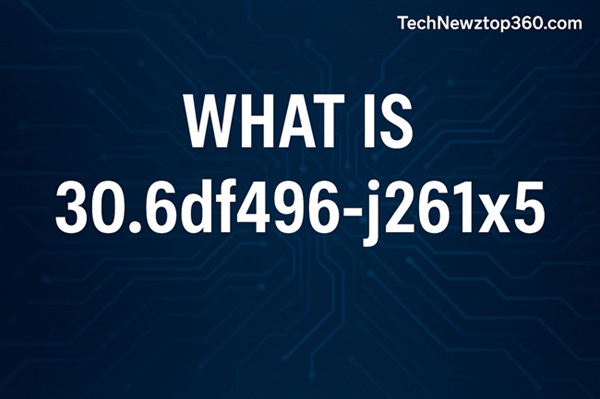By TechNewzTop360 Editorial Team
In today’s hyper-connected digital world, codes and identifiers silently power everything — from mobile apps to massive cloud systems. One such mysterious code that has caught everyone’s attention lately is 30.6df496–j261x5.
At first glance, it looks like a random mix of numbers and letters — but look closer, and you’ll realize there’s more beneath the surface. So, what exactly is 30.6df496–j261x5, and why has it become such a topic of curiosity?
In this comprehensive guide, we’ll decode its possible meaning, explore its real-world applications, and show how it fits within today’s growing landscape of smart software identifiers and machine-readable codes.
What Is 30.6df496–j261x5?
30.6df496–j261x5 is an alphanumeric identifier, meaning it combines letters, numbers, and symbols in a specific format. Such codes are frequently used across software development, digital security, and device configuration systems.
At its core, this code might represent:
- A software or firmware version number (e.g., “30.6”)
- A unique identifier for a project or component (“df496”)
- A sub-category tag or region reference (“j261x5”)
In essence, 30.6df496–j261x5 could act like a digital fingerprint — unique, traceable, and structured for machine interpretation.
If you’ve read our article on What Is DK380C4.0-H8? Features, Specs, and Uses Explained, you’ll notice the similarity in how both identifiers serve as structured codes used to manage or represent devices and systems efficiently.
Why 30.6df496–j261x5 Is Trending Online
This code started gaining traction across tech communities, mainly because it appeared in update logs, beta software builds, and encrypted datasets. Whenever something unknown yet structured pops up online, curiosity follows.
People often try to decode such strings — hoping they reveal upcoming technology, firmware updates, or hidden AI models.
It’s similar to how developers and enthusiasts analyzed the Doge Software Licenses Audit HUD when it first surfaced — a system that also used structured data identifiers to track license activity and system usage in real time.
This combination of mystery, structure, and innovation is what keeps codes like 30.6df496–j261x5 trending in digital circles.
Breaking Down the Code Structure
To understand 30.6df496–j261x5, let’s split it into components:
🔹 “30.6” — Version or Revision Number
Likely represents a software or system version, tracking release changes or feature updates.
🔹 “df496” — Module or Component Identifier
This middle section often points to a specific file group, hardware component, or API endpoint within a project.
🔹 “j261x5” — Feature or Batch Tag
This section can indicate sub-versions, testing batches, or internal configurations.
Together, they create a logical, traceable pattern — allowing engineers to instantly locate or verify files in massive digital environments.
Real-World Applications of 30.6df496–j261x5
Codes like this appear in nearly every tech field. Here are the most relevant areas:
💻 Software Development
Systems such as GitHub or Bitbucket use similar alphanumeric hashes to track code commits. Each build, version, or hotfix receives a unique tag like 30.6df496–j261x5, ensuring every change is traceable.
☁️ Cloud Computing & APIs
Cloud systems like AWS and Azure use structured identifiers for server tagging, resource tracking, and access control.
🧠 Artificial Intelligence
Machine learning datasets and AI models use identifiers for training runs and parameter tracking — a practice detailed in guides like our QY-45Y3-Q8W32 Model Guide , which explains how model codes represent specific AI architectures.
🏭 Industrial Systems
Manufacturers rely on versioned identifiers to manage embedded firmware and IoT components — ensuring every sensor or device runs the correct code version.
🏦 Financial & Security Platforms
Encrypted tokens similar to 30.6df496–j261x5 protect sensitive transactional data and help authenticate users or devices securely.
Why Codes Like 30.6df496–j261x5 Matter in Technology
Identifiers may seem trivial, but they form the foundation of digital order and traceability. Without them, systems would lose track of files, configurations, or device identities.
Here’s why they matter:
- Uniqueness: Ensures no duplication of records or files.
- Traceability: Every update or version can be located instantly.
- Security: Conceals internal structure and prevents unauthorized access.
In other words, they help computers speak in structure — ensuring systems function accurately and securely.
Security and Privacy Aspects
Cybersecurity depends heavily on structured identifiers. Codes like 30.6df496–j261x5 act as secure reference points in encrypted databases, allowing authentication without revealing actual file or user names.
For example:
- In databases, these strings function as tokens that safely link to sensitive data.
- In APIs, they prevent predictable URL patterns, protecting from brute-force attacks.
- In version control, they ensure data integrity across teams.
As privacy standards evolve, such identifiers help companies meet compliance requirements while maintaining smooth functionality.
Comparison with Similar Identifiers
| Code Type | Example | Use Case |
|---|---|---|
| UUID (Universally Unique Identifier) | 9f2b4d6e-62a8-4ab9-bb32-76b3c6a7ff51 |
Identifies resources across systems. |
| Git Hash | c3a5d1f |
Tracks code commits in software repositories. |
| AWS Resource Tag | i-0ab12cd34ef567890 |
Organizes cloud resources. |
| Custom System ID (like 30.6df496–j261x5) | 30.6df496–j261x5 |
Links internal updates or devices. |
Compared to these, 30.6df496–j261x5 stands out for its concise yet descriptive structure, balancing human readability with machine precision.
How to Decode Similar Codes
Here’s a simple step-by-step to interpret identifiers like 30.6df496–j261x5:
- Check the Prefix (Numbers): Usually indicates version or release.
- Analyze Middle Characters: Often module or data group identifiers.
- Observe Separators (like “–”): Divide major segments for readability.
- Context Is Key: The system or source where you found it tells what it represents.
If you encounter similar patterns, cross-reference them with technical documents or release notes — many companies include internal code mappings in their changelogs.
Common Misconceptions About 30.6df496–j261x5
Let’s clear up some confusion around these codes:
❌ It’s not malware or a hacking code.
✅ It’s likely a harmless internal identifier.
❌ It doesn’t unlock secret programs.
✅ It helps systems manage internal updates efficiently.
❌ It’s random gibberish.
✅ It follows structured, logical rules based on versioning and encryption.
Understanding this reinforces how digital environments remain organized and predictable even beneath layers of complex automation.
Future of Alphanumeric Identifiers
As we step deeper into AI and IoT ecosystems, identifiers like 30.6df496–j261x5 will become even more advanced. Expect innovations such as:
- AI-Generated Identifiers: Automatically assigned codes for neural model tracking.
- Quantum-Resistant Encryption: Safer, more complex ID generation to prevent future cyber threats.
- Self-Authenticating IDs: Blockchain-based systems that verify code legitimacy on their own.
These trends ensure digital systems remain traceable, secure, and scalable — no matter how large or interconnected they become.
Conclusion
The mysterious code 30.6df496–j261x5 represents far more than random characters. It’s a compact yet powerful structure that keeps our digital world organized.
From AI models to firmware identifiers, such codes manage millions of operations invisibly behind every app, database, and smart device.
Just like the Doge Software Licenses Audit HUD or QY-45Y3-Q8W32 Model Guide , the 30.6df496–j261x5 code shows how human logic and machine precision combine to create structured digital ecosystems.
Stay curious — and stay tuned to TechNewzTop360 for more deep dives into decoding technology’s hidden layers.
FAQs About 30.6df496–j261x5
It’s an alphanumeric identifier used in technology for versioning, encryption, or system tracking.
It could be an internal or symbolic representation used in software or hardware builds.
To ensure uniqueness, traceability, and security within complex systems.
Not fully, but you can interpret version and batch segments based on context.
Yes — they’re part of secure digital infrastructure design.
All are structured identifiers representing models, firmware, or software builds, each used for specific technical management.
It improves your awareness of how software and digital systems stay organized and secure.




